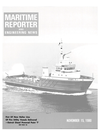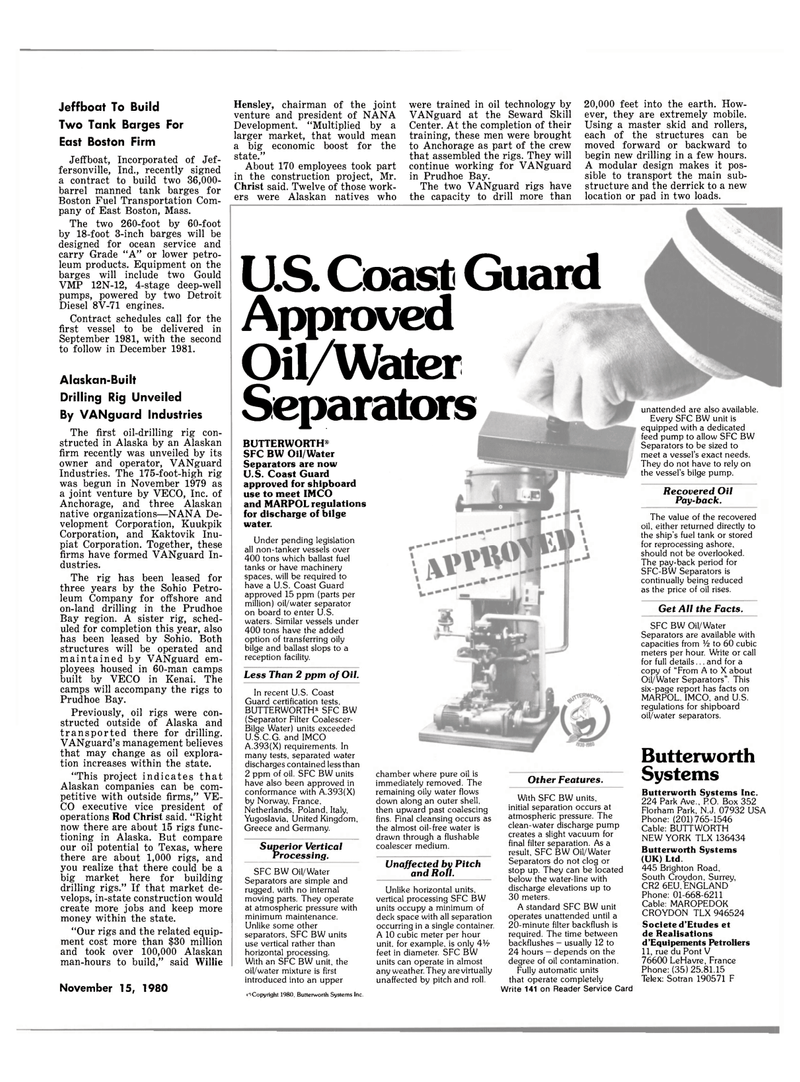
Page 15: of Maritime Reporter Magazine (November 15, 1980)
Read this page in Pdf, Flash or Html5 edition of November 15, 1980 Maritime Reporter Magazine
Jeffboat To Build
Two Tank Barges For
East Boston Firm
Jeffboat, Incorporated of Jef- fersonville, Ind., recently signed a contract to build two 36,000- barrel manned tank barges for
Boston Fuel Transportation Com- pany of East Boston, Mass.
The two 260-foot by 60-foot by 18-foot 3-inch barges will be designed for ocean service and carry Grade "A" or lower petro- leum products. Equipment on the barges will include two Gould
VMP 12N-12, 4-stage deep-well pumps, powered by two Detroit
Diesel 8V-71 engines.
Contract schedules call for the first vessel to be delivered in
September 1981, with the second to follow in December 1981.
Alaskan-Built
Drilling Rig Unveiled
By VANguard Industries
The first oil-drilling rig con- structed in Alaska by an Alaskan firm recently was unveiled by its owner and operator, VANguard
Industries. The 175-foot-high rig was begun in November 1979 as a joint venture by VECO, Inc. of
Anchorage, and three Alaskan native organizations—NANA De- velopment Corporation, Kuukpik
Corporation, and Kaktovik Inu- piat Corporation. Together, these firms have formed VANguard In- dustries.
The rig has been leased for three years by the Sohio Petro- leum Company for offshore and on-land drilling in the Prudhoe
Bay region. A sister rig, sched- uled for completion this year, also has been leased by Sohio. Both structures will be operated and maintained by VANguard em- ployees housed in 60-man camps built by VECO in Kenai. The camps will accompany the rigs to
Prudhoe Bay.
Previously, oil rigs were con- structed outside of Alaska and transported there for drilling.
VANguard's management believes that may change as oil explora- tion increases within the state. "This project indicates that
Alaskan companies can be com- petitive with outside firms," VE-
CO executive vice president of operations Rod Christ said. "Right now there are about 15 rigs func- tioning in Alaska. But compare our oil potential to Texas, where there are about 1,000 rigs, and you realize that there could be a big market here for building drilling rigs." If that market de- velops, in-state construction would create more jobs and keep more money within the state. "Our rigs and the related equip- ment cost more than $30 million and took over 100,000 Alaskan man-hours to build," said Willie
November 15, 1980 17
Hensley, chairman of the joint venture and president of NANA
Development. "Multiplied by a larger market, that would mean a big economic boost for the state."
About 170 employees took part in the construction project, Mr.
Christ said. Twelve of those work- ers were Alaskan natives who were trained in oil technology by
VANguard at the Seward Skill
Center. At the completion of their training, these men were brought to Anchorage as part of the crew that assembled the rigs. They will continue working for VANguard in Prudhoe Bay.
The two VANguard rigs have the capacity to drill more than 20,000 feet into the earth. How- ever, they are extremely mobile.
Using a master skid and rollers, each of the structures can be moved forward or backward to begin new drilling in a few hours.
A modular design makes it pos- sible to transport the main sub- structure and the derrick to a new location or pad in two loads.
U.S. Coast Guard Approved
Oil/Water Separators
Recovered Oil
Pay-back.
The value of the recovered oil, either returned directly to the ship's fuel tank or stored for reprocessing ashore, should not be overlooked.
The pay-back period for
SFC-BW Separators is continually being reduced as the price of oil rises.
Get All the Facts.
SFC BW Oil/Water
Separators are available with capacities from V2 to 60 cubic meters per hour. Write or call for full details... and for a copy of "From A to X about
Oil/Water Separators". This six-page report has facts on
MARPOL, 1MCO, and U.S. regulations for shipboard oil/water separators.
Butterworth
Systems
Butterworth Systems Inc. 224 Park Ave., RO. Box 352
Florham Park, N.J. 07932 USA
Phone: (201)765-1546
Cable: BUTTWORTH
NEW YORK TLX 136434
Butterworth Systems (UK) Ltd. 445 Brighton Road,
South Croydon, Surrey,
CR2 6EU, ENGLAND
Phone: 01-668-6211
Cable: MAROPEDOK
CROYDON TLX 946524
Societe d'Etudes et de Realisations d'Equipements Petroliers 11, rue du Pont V 76600 LeHavre, France
Phone: (35) 25.81.15
Telex: Sotran 190571 F
Less Than 2 ppm of Oil. unattended are also available.
Every SFC BW unit is equipped with a dedicated feed pump to allow SFC BW
Separators to be sized to meet a vessel's exact needs.
They do not have to rely on the vessel's bilge pump.
BUTTERWORTH*
SFC BW Oil/Water
Separators are now
U.S. Coast Guard approved for shipboard use to meet IMCO and MARPOL regulations for discharge of bilge water.
Under pending legislation all non-tanker vessels over 400 tons which ballast fuel tanks or have machinery spaces, will be required to have a U.S. Coast Guard approved 15 ppm (parts per million) oil/water separator on board to enter U.S. waters. Similar vessels under 400 tons have the added option of transferring oily bilge and ballast slops to a reception facility.
In recent U.S. Coast
Guard certification tests.
BUTTERWORTH* SFC BW (Separator Filter Coalescer-
Bilge Water) units exceeded
U.S.C.G. and IMCO
A.393(X) requirements. In many tests, separated water discharges contained less than 2 ppm of oil. SFC BW units have also been approved in conformance with A.393(X) by Norway, France,
Netherlands, Poland, Italy,
Yugoslavia, United Kingdom,
Greece and Germany.
Superior Vertical
Processing.
SFC BW Oil/Water
Separators are simple and rugged, with no internal moving parts. They operate at atmospheric pressure with minimum maintenance.
Unlike some other separators, SFC BW units use vertical rather than horizontal processing.
With an SFC BW unit, the oil/water mixture is first introduced into an upper (^Copyright 1980, Butterworth Systems Inc. chamber where pure oil is immediately removed. The remaining oily water flows down along an outer shell, then upward past coalescing fins. Final cleansing occurs as the almost oil-free water is drawn through a flushable coalescer medium.
Unaffected by and Roll.
Pitch
Unlike horizontal units, vertical processing SFC BW units occupy a minimum of deck space with all separation occurring in a single container.
A 10 cubic meter per hour unit, for example, is only 4'/i> feet in diameter. SFC BW units can operate in almost any weather. They are virtually unaffected by pitch and roll.
Other Features.
With SFC BW units, initial separation occurs at atmospheric pressure. The clean-water discharge pump creates a slight vacuum for final filter separation. As a result, SFC BW Oil/Water
Separators do not clog or stop up. They can be located below the water-line with discharge elevations up to 30 meters.
A standard SFC BW unit operates unattended until a 20-minute filter backflush is required. The time between backflushes - usually 12 to 24 hours - depends on the degree of oil contamination.
Fully automatic units that operate completely
Write 141 on Reader Service Card

 14
14

 16
16
